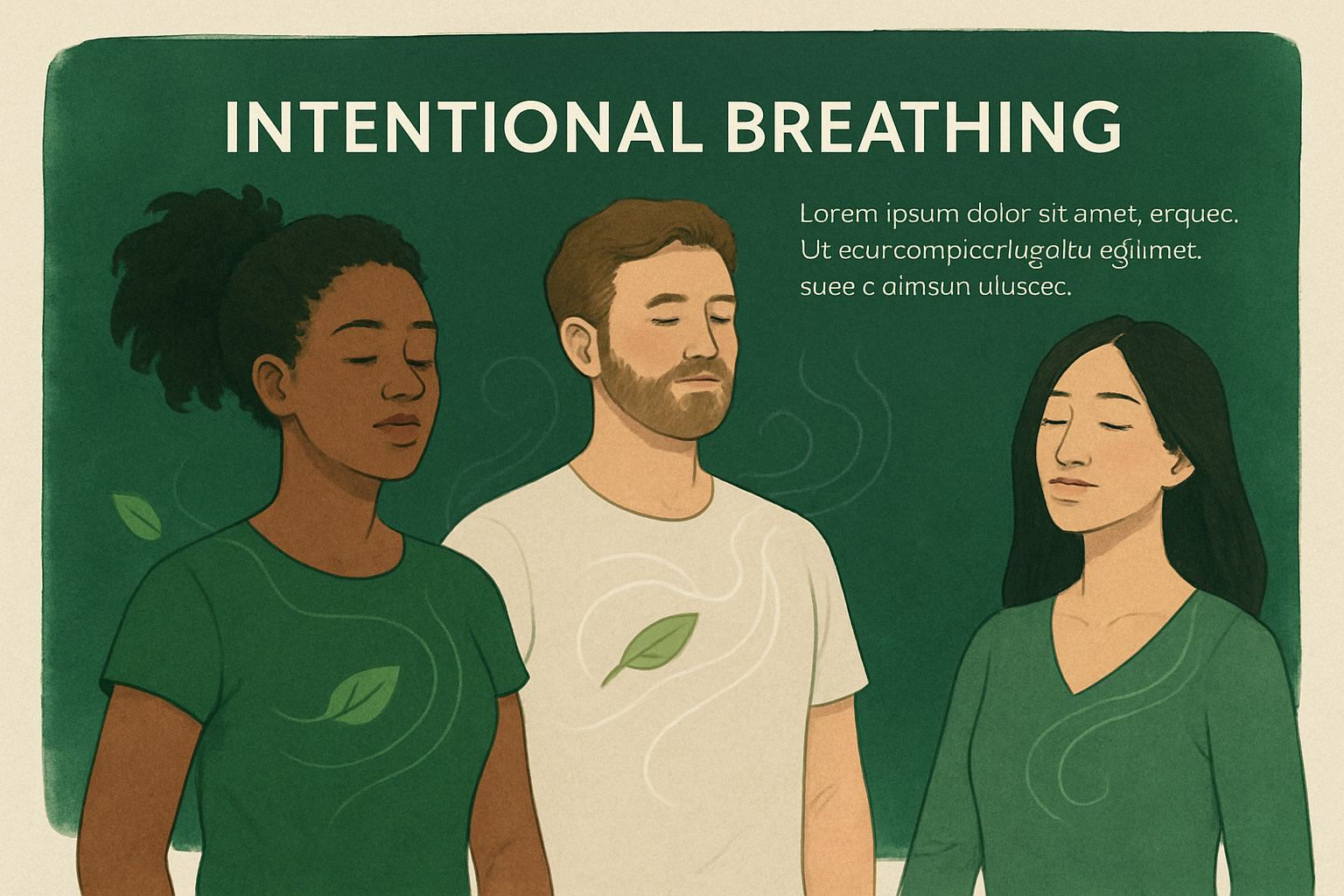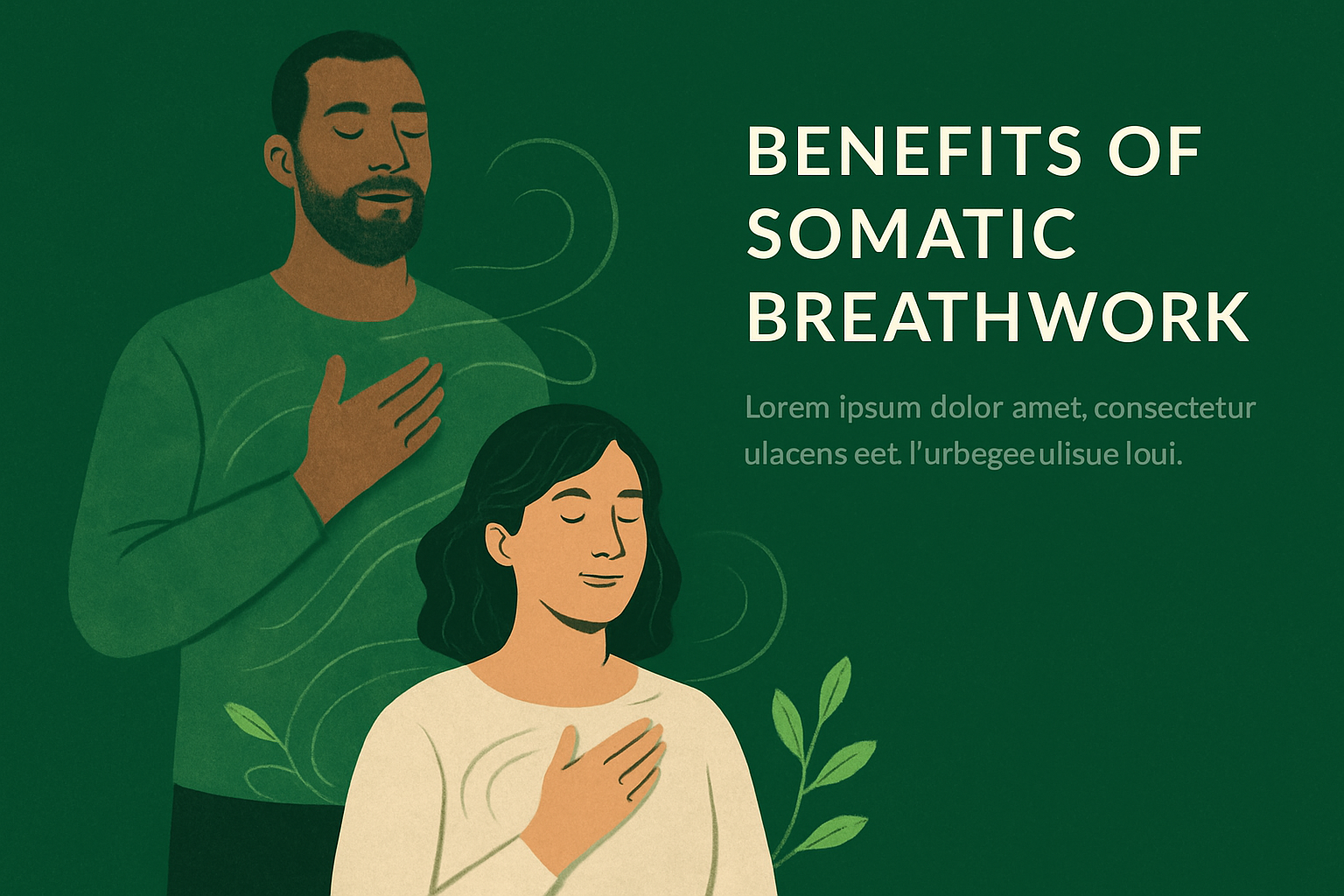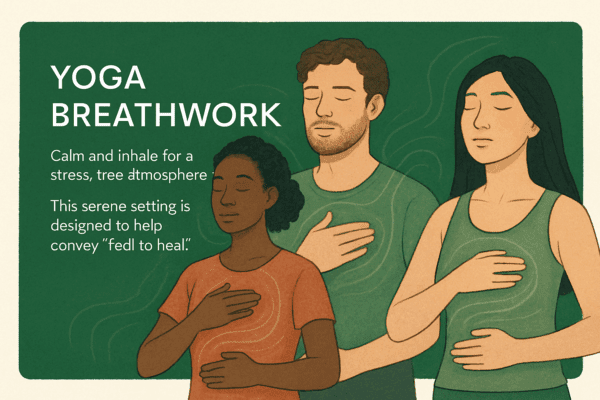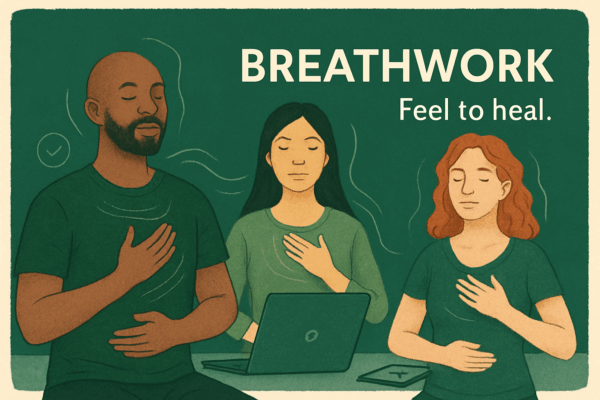Imagine unlocking deep relaxation, emotional healing, and mental clarity through a simple, natural resource: your breath. In a world where stress, anxiety, and trauma are rising, many seek holistic solutions that truly work.
This guide dives into somatic breathwork, a powerful mind-body practice backed by science and trusted by experts. You’ll discover practical techniques, real-life benefits, and simple ways to integrate this transformative approach into daily life.
Ready to take control of your well-being? Explore the full guide to learn how somatic breathwork can help you feel calmer, clearer, and more resilient.
What Is Somatic Breathwork?
Imagine taking a breath that not only calms your mind but also unlocks deep layers of healing within your body. That’s the promise of somatic breathwork—a practice rooted in the connection between your breath, your body, and your emotions.

Definition and Core Principles
Somatic breathwork is a mind-body therapy that weaves together conscious breathing, body awareness, and emotional regulation. The word “somatic” comes from the Greek “soma,” meaning body. This approach is unique because it centers on how intentional breathing can bridge the gap between our physical sensations and psychological states.
Unlike general breathwork practices, somatic breathwork specifically emphasizes tuning into the body’s sensations. For example, you might notice tension in your shoulders or tightness in your chest as you breathe. By bringing awareness to these sensations, you can begin to release stored emotions and restore balance to your nervous system.
Core principles include:
- Using breath as a bridge between mind and body.
- Focusing on present-moment sensations.
- Encouraging emotional expression and trauma release.
- Supporting nervous system regulation.
Somatic breathwork draws from both Eastern traditions—such as yoga and pranayama—and Western psychological approaches like somatic experiencing. Since the 1970s, its adoption in therapeutic settings has grown steadily, with more people seeking holistic ways to address stress, anxiety, and trauma.
To get a deeper look at the foundations of this practice, check out this What is Somatic Breathwork resource for a comprehensive overview.
Somatic Breathwork vs. Traditional Psychotherapy
Traditional psychotherapy, like cognitive behavioral therapy (CBT), relies on a top-down approach—starting with thoughts and beliefs to shift behavior and emotion. In contrast, somatic breathwork takes a bottom-up approach, beginning with the body and its sensations to influence the mind.
This difference is especially important for people who struggle to express emotions verbally. Somatic breathwork helps clients access and process feelings that may be difficult to articulate. For instance, someone with trauma might find it easier to release tension through breath and movement than through conversation alone.
Many therapists now blend somatic breathwork with cognitive therapies, recognizing that body-based practices can support healing from anxiety, depression, and PTSD. Statistics show a steady rise in mental health professionals incorporating somatic methods for comprehensive care.
Ultimately, somatic breathwork offers a holistic alternative for anyone seeking more than traditional talk therapy. It empowers individuals to listen to their bodies, release what no longer serves them, and cultivate lasting well-being.
The Science Behind Somatic Breathwork
Understanding the science behind somatic breathwork reveals why this practice is so transformative for both mind and body. By tapping into the body’s natural systems, it empowers you to regulate stress, process emotions, and even reshape your mental patterns. Let’s break down how it works, step by step.

How Somatic Breathwork Influences the Nervous System
At the core of somatic breathwork is its ability to influence the autonomic nervous system (ANS), which controls automatic bodily functions like heart rate, breathing, and digestion. The ANS is divided into two branches: the sympathetic system (responsible for “fight or flight”) and the parasympathetic system (“rest and digest”).
When you experience chronic stress or trauma, your body can become trapped in sympathetic overdrive. This means your heart rate stays elevated, muscles remain tense, and stress hormones like cortisol circulate at high levels. Somatic breathwork uses intentional, controlled breathing to shift the body out of this heightened state.
For example, deep, slow breaths signal safety to the brain, activating the parasympathetic system. This leads to lowered heart rate, reduced blood pressure, and muscle relaxation. Research shows that specific breathwork practices can reduce stress markers and enhance vagal tone, which is crucial for emotional regulation and recovery.
A recent meta-analysis on breathwork and stress found significant reductions in anxiety and physiological stress in participants using somatic breathwork techniques. This growing body of evidence highlights the profound impact of breath on the body’s stress response.
Summary Table: Physiological Effects of Somatic Breathwork
| Response | Sympathetic State | After Somatic Breathwork |
|---|---|---|
| Heart rate | Elevated | Decreased |
| Muscle tension | High | Relaxed |
| Cortisol levels | Increased | Reduced |
| Breathing pattern | Shallow, rapid | Deep, slow |
Neuroplasticity and Emotional Regulation
Somatic breathwork doesn’t just calm the body—it also rewires the brain. Neuroplasticity is the brain’s ability to form new connections and adapt in response to experience. Through regular breathwork, you can retrain your stress responses and cultivate healthier emotional patterns.
Breathwork techniques help regulate the amygdala (the brain’s fear center) and strengthen the prefrontal cortex, which governs decision-making and emotional control. This means that over time, you become less reactive to triggers and more resilient during stressful situations.
Scientific studies have shown that somatic breathwork can reduce symptoms of anxiety and depression by improving emotional regulation. For instance, people recovering from trauma often find it hard to express their feelings in words. By focusing on bodily sensations and breath, they gain access to emotions stored deep within the nervous system.
Consider the story of a trauma survivor who struggled with panic attacks. Through consistent somatic breathwork, they learned to recognize early signs of distress in the body and use breath to regain calm. This “bottom-up” approach empowers individuals to shift emotional states from within, rather than relying solely on cognitive strategies.
Somatic Memory and Trauma Release
One of the most powerful aspects of somatic breathwork is its ability to access and release somatic memories—emotional or traumatic experiences stored in the body. These memories often show up as unexplained tension, discomfort, or even pain.
During breathwork sessions, you may notice sensations like tightness in the chest or a lump in the throat. These physical cues are gateways to deeper emotional healing. By staying present and breathing through them, the body can safely process and release old patterns.
Research supports the use of somatic breathwork for trauma processing and somatic release. Clients often report a sense of lightness or emotional relief after sessions, as if a burden has been lifted. This holistic approach bridges the gap between body and mind, offering a pathway to lasting healing.
Whether you’re seeking relief from everyday stress or working through deeper trauma, somatic breathwork offers a science-backed method to help you reconnect, regulate, and heal.
Core Somatic Breathwork Techniques (Step-by-Step Guide)
Mastering somatic breathwork starts with understanding its foundational and advanced techniques. Whether you’re new or experienced, following structured steps can help you unlock the full potential of this mind-body practice. Let’s break down each core area so you can confidently integrate somatic breathwork into your routine.

Foundational Breathing Practices
The foundation of somatic breathwork lies in simple, effective breathing patterns. These techniques help you reconnect with your body and regulate your nervous system.
Diaphragmatic Breathing (Abdominal Breathing):
- Sit or lie comfortably, one hand on your belly.
- Inhale slowly through your nose, letting your abdomen expand fully.
- Exhale gently through your mouth, feeling your belly fall.
- Repeat for 1–2 minutes, focusing on the movement of your breath.
Box Breathing:
- Inhale for 4 counts.
- Hold your breath for 4 counts.
- Exhale for 4 counts.
- Hold again for 4 counts.
- Continue for several cycles to promote calm and focus.
4-7-8 Breathing:
- Inhale quietly through your nose for 4 counts.
- Hold your breath for 7 counts.
- Exhale slowly and completely for 8 counts.
- Repeat 4 times to soothe anxiety and prepare your body for relaxation.
These foundational practices in somatic breathwork create immediate shifts in how you feel. Over time, you’ll notice increased body awareness and emotional stability. Start with just five minutes daily and gradually increase as you become more comfortable.
Advanced Somatic Techniques
Once you’re comfortable with the basics, you can explore advanced somatic breathwork techniques. These methods offer deeper nervous system regulation and emotional release.
Double Inhale Method:
- Take a short inhale, then immediately take a second, deeper inhale.
- Exhale slowly through the mouth.
- Repeat for 5–10 cycles to reset your system.
Bilateral Stimulation (Snap, Snap, Clap):
- Inhale deeply, snap your right fingers.
- Exhale, snap your left fingers.
- Inhale, clap both hands together.
- Repeat this sequence to help integrate both brain hemispheres.
Anxiety-Busting Breath (Extended Exhale with Humming):
- Inhale through your nose.
- Exhale slowly while gently humming.
- Focus on the vibration in your chest and throat.
- This technique calms the mind and soothes tension.
Somatic Movement Integration:
- Pair slow, rhythmic breathing with gentle movements, like rolling shoulders or swaying arms.
- Notice how breath and movement together release stored tension.
Try this 10-minute session:
- Start with diaphragmatic breathing (2 min).
- Move to box breathing (2 min).
- Practice the double inhale method (2 min).
- Add bilateral stimulation (2 min).
- Finish with the anxiety-busting breath (2 min).
To dive deeper into how advanced techniques support trauma healing and nervous system balance, explore the BBTRS® Sound & Trauma Techniques for science-backed guidance.
Trauma-Informed Approaches
Safety and consent are the backbone of any trauma-informed somatic breathwork practice. Creating a supportive environment allows for gentle, effective healing.
Key Principles:
- Always check in with yourself or your client before starting.
- Set clear intentions and boundaries for each session.
- Use gradual exposure—start with milder techniques and build intensity over time.
- Allow emotions to surface without pressure or judgment.
Practitioner-Guided vs. Self-Guided:
- Practitioner-guided sessions offer a safe container, especially for those with trauma histories.
- Self-guided practices work well for ongoing maintenance but should be approached mindfully.
Example Protocol:
- Begin with a grounding exercise, like feeling your feet on the floor.
- Use slow, conscious breathing, stopping if you feel overwhelmed.
- Debrief with journaling or gentle movement after each session.
Somatic breathwork honors your body’s pace. By focusing on safety, you create space for authentic emotional expression and sustainable healing.
Common Mistakes and How to Avoid Them
Even experienced practitioners can run into challenges with somatic breathwork. Awareness of common mistakes helps ensure your practice is both safe and effective.
Mistakes to Watch For:
- Over-breathing or hyperventilating, which can cause dizziness or tingling.
- Ignoring bodily signals, leading to emotional overwhelm or shutdown.
- Skipping integration time after intense sessions.
Tips for Safe Practice:
- Always breathe at a pace that feels natural.
- Pause immediately if you experience discomfort or strong emotional reactions.
- After each session, take a few minutes to rest, hydrate, and reflect.
Listening to your body and pacing yourself are crucial. With mindful attention and support, somatic breathwork becomes a powerful tool for growth and resilience.
Benefits of Somatic Breathwork
Discovering the benefits of somatic breathwork can feel like unlocking a new level of well-being. Whether you’re looking for physical relief, emotional balance, or sharper focus, this practice offers something for everyone. Let’s explore how somatic breathwork can enhance your daily life.

Physical Benefits
Somatic breathwork has a profound impact on the body. By using intentional breathing patterns, you can lower your heart rate and blood pressure, which supports cardiovascular health. Research shows that slow, deep breaths improve lung capacity and oxygenation, helping you feel more energized.
Many people notice reduced muscle tension and less chronic pain after regular practice. This is especially true for individuals who struggle with tension headaches or fatigue. Enhanced immune function is another benefit, as mindful breathing can decrease stress hormones that suppress the immune system.
Here’s a quick comparison of physical benefits:
| Benefit | Description |
|---|---|
| Lower Heart Rate | Promotes calm and relaxation |
| Better Oxygenation | Boosts energy and mental clarity |
| Less Muscle Tension | Eases aches and chronic pain |
| Stronger Immunity | Helps the body fight off illness |
Somatic breathwork provides a foundation for physical vitality and resilience.
Emotional and Mental Health Benefits
The emotional effects of somatic breathwork are equally transformative. Regular practice can lower anxiety and depression symptoms, making it easier to manage daily stress. Improved emotional regulation means you’re less likely to feel overwhelmed by intense feelings.
One powerful aspect is the release of trapped emotions and trauma. By tuning into the body’s sensations, you create space for healing at a deep level. For example, a trauma survivor might experience an emotional breakthrough after a guided session, feeling lighter and more at ease. For more on this process, explore Trauma Healing with Breathwork.
Somatic breathwork also builds resilience to future stressors, helping you bounce back more quickly when life gets tough.
Cognitive and Lifestyle Benefits
Somatic breathwork sharpens the mind as much as it soothes the body. Many people report enhanced focus, mental clarity, and better decision-making after just a few sessions. This is especially helpful for professionals who need to stay sharp under pressure.
Better sleep quality is another major benefit. Practicing breathwork before bed can calm racing thoughts and prepare you for restful sleep. Over time, this leads to greater self-acceptance and confidence, as you become more in tune with your body’s needs.
Here are some ways somatic breathwork supports daily life:
- Boosts creativity and performance at work
- Makes transitions between tasks smoother
- Encourages mindful living and self-reflection
Somatic breathwork truly integrates wellness into every part of your routine.
Research and Evidence
The benefits of somatic breathwork aren’t just anecdotal—they’re backed by science. Numerous studies show that slow breathing techniques reduce heart rate, blood pressure, and levels of the stress hormone cortisol. Clinical trials report significant improvements in anxiety, depression, and trauma-related symptoms.
Participant testimonials echo these findings, with many describing increased calm, better focus, and a greater sense of well-being. In fact, the number of health professionals recommending somatic breathwork continues to grow each year, as more evidence emerges about its therapeutic impact.
With a robust foundation in both research and real-world experience, somatic breathwork stands as a trusted practice for holistic health.
Integrating Somatic Breathwork Into Daily Life
Building a sustainable somatic breathwork routine doesn’t require drastic life changes—it’s about weaving mindful breathing into the fabric of your day. With consistent, practical steps, you can transform daily stress into opportunities for calm, clarity, and self-connection.
Creating a Consistent Practice
Consistency is key for experiencing the full benefits of somatic breathwork. Start by setting aside 5–20 minutes each day, choosing a time that works for your schedule—morning, midday, or evening. If you’re new, even a few focused minutes can make a difference.
Here’s a simple daily routine to get you started:
- Morning reset: Begin your day with 5 minutes of gentle diaphragmatic breathing.
- Midday pause: Practice box breathing before lunch or meetings to refocus.
- Evening unwind: Use 4-7-8 breathing to transition into restful sleep.
Integrate somatic breathwork into stressful moments as well. For example, notice your breath when you feel tension rising, and take a few slow, intentional inhales and exhales. Over time, these brief check-ins help regulate your nervous system and keep you grounded throughout the day.
For more ideas on how to use somatic breathwork for daily stress and trauma relief, explore this Somatic Breathwork for Stress Relief resource.
Combining With Other Wellness Practices
Somatic breathwork pairs seamlessly with other holistic practices. Try combining breathwork with meditation by starting your session with a few minutes of focused breathing. This primes your mind and body for deeper presence.
Pairing breathwork with mindful movement, such as yoga or gentle stretching, can amplify relaxation and body awareness. After a session, journaling about your sensations or emotions can help you process and integrate your experience.
Some people find that adding a body scan or gratitude practice after somatic breathwork enhances emotional regulation and clarity. These combinations deepen the positive effects and create a more holistic approach to well-being.
For those interested in the scientific benefits of slow, intentional breathing, this overview on the Benefits of Slow Breathing explains how these techniques support overall health and balance.
Overcoming Common Barriers
It’s natural to encounter resistance or skepticism when starting a somatic breathwork practice. You might wonder if it really works or struggle to stay motivated. Overcome these barriers by setting small, achievable goals and tracking your progress in a journal or app.
If you need support, consider joining an online community or finding a local group. Sharing your experiences and learning from others can boost accountability and confidence. For those with complex trauma or health concerns, seeking guidance from a certified practitioner ensures a safe, tailored approach.
Remember, somatic breathwork is adaptable. If you miss a day, simply start again. By listening to your body and respecting your limits, you can create a sustainable, rewarding practice that supports your mental and physical well-being.
Who Can Benefit and Safety Considerations
Somatic breathwork offers a versatile path to well-being for many people. This approach is especially helpful for those seeking relief from stress, unresolved trauma, or challenges with emotional regulation. Individuals managing anxiety, depression, PTSD, or chronic health conditions often find that somatic breathwork supports their healing journey. Professionals and caregivers also use these techniques for self-care and to empower others. Many people report increased calm and clarity after starting a somatic breathwork practice. For a broader look at how these methods can enhance overall wellness, see this Somatic Therapy Techniques Overview.
Ideal Candidates for Somatic Breathwork
Somatic breathwork is accessible to a wide range of people. If you’re looking for natural ways to manage stress, process emotions, or improve your mental clarity, this practice could be a fit. Those with a history of trauma or difficulty expressing emotions often find somatic breathwork particularly supportive.
You might benefit from somatic breathwork if you:
- Experience anxiety, depression, or chronic stress
- Seek a holistic approach to trauma recovery
- Want to enhance self-awareness and emotional resilience
- Are a caregiver or therapist aiming to support others
People from all backgrounds report positive changes, from feeling more grounded to gaining new perspectives on personal challenges.
Contraindications and Precautions
While somatic breathwork is generally safe, some individuals should proceed with caution. If you have severe respiratory or cardiac conditions, epilepsy, or are pregnant, consult your healthcare provider before starting. Those with a history of severe trauma may benefit from working with a trauma-informed practitioner.
It’s important to adapt somatic breathwork techniques to your unique needs. Start slowly, and never push past your comfort zone. For more on safely processing emotions during breathwork, explore this resource on Emotional Release in Breathwork.
Maximizing Benefits Safely
To get the most from somatic breathwork, listen to your body and respect its limits. Begin with short sessions and gradually increase intensity as you gain confidence. After each session, allow time for rest or gentle integration activities like journaling or stretching.
Consider joining a supportive community or seeking guidance from certified practitioners. These steps help ensure your somatic breathwork practice remains both effective and safe, allowing you to enjoy its full range of benefits.
If you’re feeling inspired to experience the benefits of somatic breathwork for yourself—whether you’re looking to reduce stress, process emotions, or simply reconnect with your body—there’s no better time to start than now. You don’t have to go it alone; guided support makes all the difference, and you can begin exploring these powerful techniques right from home. Take the first step on your transformation journey, deepen your personal growth, and see how breathwork can fit into your daily life by joining us online. Start your transformation journey from the comfort of your home.





